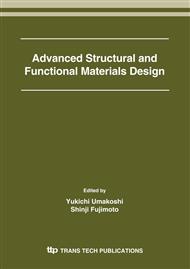p.265
p.269
p.281
p.289
p.295
p.301
p.305
p.309
p.313
Fabrication and Properties of Porous Materials with Directional Elongated Pores
Abstract:
Lotus-type porous materials whose long cylindrical pores are aligned in one direction were fabricated by unidirectional solidification from the melt dissolving gas. The pores were evolved by supersaturation of gas atoms when the liquid was solidified. Although such porous metals with high thermal conductivity were produced by casting process, the process could not produce porous metals with low thermal conductivity, which possess uniform pore size and porosity. In order to obtain uniform pore size and porosity in metals with low thermal conductivity, we invented a new “continuous zone melting technique”. Using this technique various metals, alloys, intermetallic compounds and semiconductors were fabricated. Mechanical properties of tensile strength on lotus-type porous metals are described; lotus-type porous iron fabricated using a pressurized nitrogen gas instead of hydrogen exhibits superior strength. The lotus materials can be applied to various functional materials. Some examples are also shown in this paper.
Info:
Periodical:
Pages:
295-300
Citation:
Online since:
April 2006
Authors:
Keywords:
Price:
Сopyright:
© 2006 Trans Tech Publications Ltd. All Rights Reserved
Share:
Citation:


